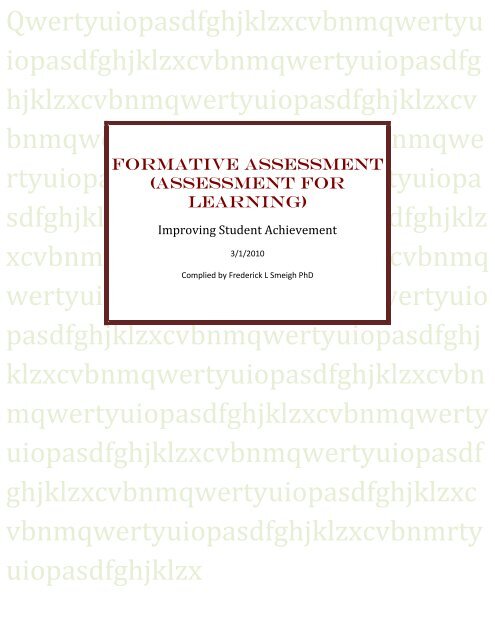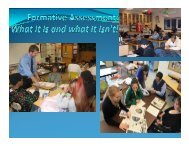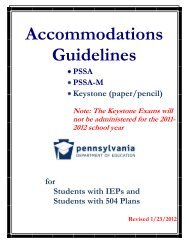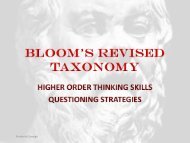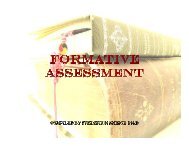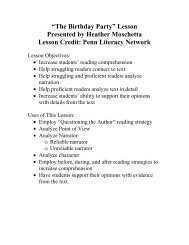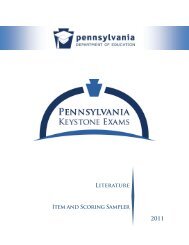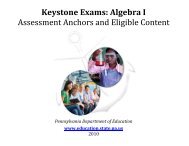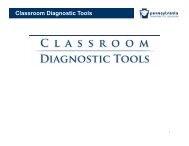FORMATIVE ASSESSMENT (Assessment for learning)
FORMATIVE ASSESSMENT (Assessment for learning)
FORMATIVE ASSESSMENT (Assessment for learning)
Create successful ePaper yourself
Turn your PDF publications into a flip-book with our unique Google optimized e-Paper software.
Qwertyuiopasdfghjklzxcvbnmqwertyu<br />
iopasdfghjklzxcvbnmqwertyuiopasdfg<br />
hjklzxcvbnmqwertyuiopasdfghjklzxcv<br />
bnmqwertyuiopasdfghjklzxcvbnmqwe<br />
<strong>FORMATIVE</strong> <strong>ASSESSMENT</strong><br />
rtyuiopasdfghjklzxcvbnmqwertyuiopa<br />
(<strong>Assessment</strong> <strong>for</strong><br />
<strong>learning</strong>)<br />
sdfghjklzxcvbnmqwertyuiopasdfghjklz<br />
Improving Student Achievement<br />
xcvbnmqwertyuiopasdfghjklzxcvbnmq<br />
3/1/2010<br />
Complied by Frederick L Smeigh PhD<br />
wertyuiopasdfghjklzxcvbnmqwertyuio<br />
pasdfghjklzxcvbnmqwertyuiopasdfghj<br />
klzxcvbnmqwertyuiopasdfghjklzxcvbn<br />
mqwertyuiopasdfghjklzxcvbnmqwerty<br />
uiopasdfghjklzxcvbnmqwertyuiopasdf<br />
ghjklzxcvbnmqwertyuiopasdfghjklzxc<br />
vbnmqwertyuiopasdfghjklzxcvbnmrty<br />
uiopasdfghjklzx
HYPERLINK TO CONTENT<br />
What is Formative <strong>Assessment</strong>?<br />
Formative <strong>Assessment</strong> and Standards Based Systems<br />
Why use?<br />
<strong>Assessment</strong> SEQUENCE<br />
PRE<strong>ASSESSMENT</strong><br />
CLASSROOM MONITORING DURING UNIT<br />
FEEDBACK<br />
SELF and PEER <strong>ASSESSMENT</strong><br />
WEB RESOURCES<br />
REFERENCES<br />
FLS Page 2
WHAT IS <strong>FORMATIVE</strong> <strong>ASSESSMENT</strong>?<br />
The following definition of <strong>for</strong>mative assessment was adopted by the Council of Chief State<br />
School Officers. The definition was developed by the Formative <strong>Assessment</strong> Advisory Group<br />
and the State Collaborative on <strong>Assessment</strong> and Student Standards and can be found in a paper on<br />
the attributes of <strong>for</strong>mative assessment prepared <strong>for</strong> the Council of Chief State School Officers.<br />
Formative assessment is a process used by teachers and students during<br />
instruction that provides feedback to adjust ongoing teaching and <strong>learning</strong> to<br />
improve student’s achievement of intended instructional outcomes.<br />
The above definition requires the following:<br />
‣ Formative assessment is not an adjunct to teaching but, rather, integrated into<br />
instruction and <strong>learning</strong> with teachers and students receiving frequent feedback.<br />
‣ Formative <strong>Assessment</strong> is a process rather than a particular type of assessment.<br />
There is no such thing as a <strong>for</strong>mative test; there are <strong>for</strong>mative assessment<br />
strategies that can be implemented during classroom instruction..<br />
‣ Formative assessment occurs constantly in the classroom.<br />
There are five attributes that have been identified to effectively implement the above<br />
definition. All of the following attributes need not be present <strong>for</strong> the assessment to be<br />
<strong>for</strong>mative.<br />
1. Learning progressions describe how concepts and skills build in a domain, and<br />
show the trajectory of <strong>learning</strong> along which students are expected to progress.<br />
2. Learning goals should be identified and communicated to the students along with<br />
the criteria by which <strong>learning</strong> will be assessed.<br />
3. Students should be provided with evidenced-based descriptive feedback that is<br />
linked to the intended instructional outcomes and criteria <strong>for</strong> success.<br />
4. Formative assessment is a process that directly engages both teachers and<br />
students. Both self and peer assessment are important <strong>for</strong> providing students an<br />
opportunity to think meta-cognitively about their <strong>learning</strong>.<br />
5. A classroom culture in which teachers and students are partners in <strong>learning</strong> should<br />
be established. Teachers need to support students as they monitor and take<br />
responsibility <strong>for</strong> their own <strong>learning</strong> by:<br />
helping students provide constructive feedback to each other,<br />
involving students in decisions about how to move <strong>learning</strong> <strong>for</strong>ward (McManus,<br />
2008)<br />
Pennsylvania defines <strong>for</strong>mative assessment as classroom based assessment that allows<br />
teachers to monitor and adjust their instructional practice in order to meet the individual<br />
FLS Page 3
needs of their students. Formative assessment can consist of <strong>for</strong>mal instruments or<br />
in<strong>for</strong>mal observations.<br />
The key is how the results are used. Results should be used to shape teaching and<br />
<strong>learning</strong>. Black and William (1998) define <strong>for</strong>mative assessment broadly to include<br />
instructional <strong>for</strong>mats that teachers utilize in order to get in<strong>for</strong>mation that when used<br />
diagnostically alter instructional practices and have a direct impact on student <strong>learning</strong><br />
and achievement. Under this definition, <strong>for</strong>mative assessment encompasses questioning<br />
strategies, active engagement check-ins, (such as response cards, white boards, random<br />
selection, think-pair-share, popsicle sticks <strong>for</strong> open-ended questions, and numbered<br />
heads) and analysis of student work based on set rubrics and standards including<br />
homework and tests.<br />
<strong>Assessment</strong>s are <strong>for</strong>mative when the in<strong>for</strong>mation is used to adapt instructional practices<br />
to meet individual student needs as well as providing individual students corrective<br />
feedback that allows them to “reach” set goals and targets. Ongoing <strong>for</strong>mative assessment<br />
is an integral part of effective instructional routines that provide teachers with the<br />
in<strong>for</strong>mation they need to differentiate and make adjustments to instructional practice in<br />
order to meet the needs of individual students.<br />
When teachers know how students are progressing and where they are having trouble, they can<br />
use this in<strong>for</strong>mation to make necessary instructional adjustments, such as re-teaching, trying<br />
alternative instructional approaches, or offering more opportunities <strong>for</strong> practice. The use of<br />
ongoing <strong>for</strong>mative classroom assessment data is an imperative. Effective teachers seamlessly<br />
integrate <strong>for</strong>mative assessment strategies into their daily instructional routines.<br />
SUPPORTING DEFINITIONS<br />
Elwood, & Klendowski (2002) believe there is a distinction between “assessment of <strong>learning</strong>”<br />
(assessment <strong>for</strong> the purposes of grading and reporting with its own established procedures) and<br />
“assessment <strong>for</strong> <strong>learning</strong>” (assessment whose purpose is to enable students, through effective<br />
feedback, to fully understand their own <strong>learning</strong> and the goals they are aiming <strong>for</strong>). <strong>Assessment</strong><br />
<strong>for</strong> <strong>learning</strong> requires teachers to never take a student’s grade in and of itself as the only central<br />
goal of the assessment. Rather, assessment per<strong>for</strong>mance is taken as a proxy <strong>for</strong> the student’s<br />
status with respect to target instructional domain (Popham, 2002).<br />
Formative assessment refers to assessment that is specifically designed to generate feedback to<br />
improve and accelerate student <strong>learning</strong> (Sadler, 1998)<br />
Formative assessment is defined as assessment carried out during the instructional process <strong>for</strong><br />
the purpose of improving teaching or <strong>learning</strong>. To be effective, teachers must be skillful in using<br />
various assessment strategies and tools such as observation, student conferences, portfolios,<br />
FLS Page 4
per<strong>for</strong>mance tasks, prior knowledge assessments, rubrics, feedback, and student self-assessment.<br />
More importantly, they must have a deep understanding of the <strong>for</strong>mative assessment process and<br />
understand its close relationship to instructional scaffolding (Shepard, Hammerness, Darling-<br />
Hammond, & Rust, 2005).<br />
Formative assessment occurs when you feed in<strong>for</strong>mation back to the student in ways that enable<br />
the students to learn better or when students engage in a similar self-reflective process. (National<br />
Center <strong>for</strong> Fair and Open Testing 2007)<br />
Many researchers have identified what constitutes <strong>for</strong>mative assessment. (Black & William,<br />
1998; Sadler, 1998b; Stiggins, 2007; Heritage, 2007a) The strategies are listed below:<br />
1. Preassessing students.<br />
2. Sharing <strong>learning</strong> goals with students.<br />
3. Employing quality classroom discourse and questioning.<br />
4. Using rich and challenging tasks that elicit students’ responses.<br />
5. Identifying the gap between where the students are now and the desired standard goal.<br />
6. Providing feedback that helps students identify how to improve.<br />
7. Using self-assessment and peer assessment.<br />
8. Providing students with opportunities to close the gap between current and desired<br />
per<strong>for</strong>mance.<br />
9. Celebrating <strong>learning</strong> progress.<br />
<strong>FORMATIVE</strong> <strong>ASSESSMENT</strong> CYCLE<br />
LEARNING PROGRESSIONS<br />
Determine goals and<br />
define creteria <strong>for</strong> success<br />
Student (s) use<br />
feedback to<br />
improve<br />
<strong>learning</strong><br />
Analyze Data<br />
Diagnose<br />
Problem<br />
Scaffold<br />
Learning<br />
Identify Gap<br />
Provide clear<br />
specific<br />
feedback<br />
Plan Learning<br />
and<br />
Instructioanal<br />
Modifications<br />
FLS Page 5
<strong>Assessment</strong> becomes <strong>for</strong>mative when the in<strong>for</strong>mation is used to adapt teaching and <strong>learning</strong> to<br />
meet student needs. When teachers know how students are progressing and where they are<br />
having trouble, they can use this in<strong>for</strong>mation to make necessary instructional adjustments, such<br />
as reteaching, trying alternative instructional approaches, or offering more opportunities <strong>for</strong><br />
practice. These activities can lead to improved student success. (Black & William, 1998)<br />
Formative assessment involves providing feedback to students and closing the gap between the<br />
learners’s current and desired state (Heritage, 2007).<br />
Formative <strong>Assessment</strong> and Standards Based<br />
Systems<br />
Formative assessment and standards-based education share many common characteristics.<br />
Curriculum and instruction are based on standards not on a textbook and assessment is used to<br />
determine student progress on the standards. Formative assessment should be designed to<br />
determine the student’s immediate progress in mastering the standard(s) being addressed.<br />
When you use <strong>for</strong>mative assessment you identify the present status of the students in terms of the<br />
<strong>learning</strong> standard, diagnose what to do to assist them, provide feedback, allow students to make<br />
the changes, and recognize their progress.<br />
Teachers are better able to determine what standards students already know and to what degree,<br />
decide what changes in instruction to make so that all students can succeed, chose appropriate<br />
instructional strategies and activities, choose appropriate groupings, and keep students in<strong>for</strong>med<br />
of their progress when to use <strong>for</strong>mative assessment.<br />
Standards that are being addressed by the course must be posted in the classroom by unit.<br />
Why use?<br />
State tests, course finals, quarterly benchmarks, and unit tests are important because they<br />
summarize students’ past <strong>learning</strong>; however, they do not help the students improve on a regular<br />
weekly basis as classroom <strong>for</strong>mative assessments do (Tuttle, 2009).<br />
Teachers generally need to undertake or participate in some summative assessment as a basis <strong>for</strong><br />
reporting grades or meeting accountability standards. However, the task of summative<br />
assessment <strong>for</strong> external purposes remains quite different from the task of <strong>for</strong>mative assessment to<br />
monitor and improve progress. While state tests provide a snapshot of a student's per<strong>for</strong>mance on<br />
a given day under test conditions, <strong>for</strong>mative assessments supply the evidence teachers need in<br />
order to adjust instructional practices so that student <strong>learning</strong> is always the outcome (Popham,<br />
2008).<br />
When teachers use <strong>for</strong>mative assessment, students can learn in six to seven months what will<br />
normally take a school year to learn. (Leahy, Lyon, Thompson & William 2005).<br />
FLS Page 6
Formative feedback is the single most powerful single<br />
moderator in the enhancement of achievement (Hattie<br />
1998).<br />
Those schools where teachers use preassessment to support<br />
targeted teaching have high achievement rates (Stronge,<br />
2002).<br />
Two experimental research studies have shown that<br />
students who understand the <strong>learning</strong> objectives and<br />
assessment criteria and have opportunities to reflect on<br />
their work show greater improvement than those who do<br />
not. (Fontana & Fernandes, 1994; Frederiksen & White,<br />
1997).<br />
Research indicates that<br />
<strong>for</strong>mative assessment works<br />
extremely well with<br />
disadvantaged students (Black<br />
& William, Inside the black<br />
box: Raising standards through<br />
classroom assessment, 1998).<br />
A review of 250 journal articles, which looked at the effects of <strong>for</strong>mative assessment on students<br />
ranging in age from primary to university undergraduates, found high effect sizes <strong>for</strong> <strong>for</strong>mative<br />
assessment. Typical effect sizes of the <strong>for</strong>mative assessment experiments were between 0.4 and<br />
0.7. These effect sizes are larger than most of those found <strong>for</strong> educational interventions. As an<br />
example, an effect size of 0.7 would mean the average student who benefited from <strong>for</strong>mative<br />
assessment would achieve a score .70 standard deviations higher than an average student who<br />
did not receive the benefits of <strong>for</strong>mative assessment. A .70 standard deviation growth equates to<br />
an approximate 25 percentile gain on a standardized test (Black & William, Inside the black box:<br />
Raising standards through classroom assessment, 1998).<br />
<strong>Assessment</strong> SEQUENCE<br />
Preassessment<br />
During Class<br />
<strong>Assessment</strong><br />
Posttest<br />
Because the goal of <strong>for</strong>mative assessment focuses on improving student <strong>learning</strong> in the specified<br />
<strong>learning</strong> goal, the first step involves eliciting student responses to reveal student thinking. The<br />
teacher needs constant feedback on what the students do and do not know (Black & William,<br />
1998; Stronge, 2002).<br />
The following graph represents the percentage of assessments that should be done at different<br />
parts of the unit. (Tuttle, 2007)<br />
FLS Page 7
100<br />
90<br />
80<br />
70<br />
60<br />
50<br />
40<br />
30<br />
20<br />
10<br />
0<br />
Pretest<br />
<strong>Assessment</strong>s<br />
Formative <strong>Assessment</strong> During<br />
Unit<br />
Posttest<br />
PRE-<strong>ASSESSMENT</strong><br />
Students should take the pre-assessment in sufficient time be<strong>for</strong>e the unit to enable the teacher to<br />
have adequate planning time to modify the instructional plan if needed.<br />
Pretests do not have to be complex but they should address the unit standards at the expected<br />
level of thinking skills (Bloom’s Revised Taxonomy) required.<br />
Recording the results on a spreadsheet makes it easy to see the class’s strengths and <strong>learning</strong><br />
gaps as well as individual student results. Teachers can then plan on strategies to close the<br />
<strong>learning</strong> gap and enrichment activities <strong>for</strong> those who are close to mastering the standards.<br />
Pretests should also be given at the beginning of the course to address the courses key concepts<br />
and competencies required to master the course standards.<br />
Formative <strong>Assessment</strong> during the Learning Process<br />
Formative assessment is tightly linked with instructional practices. Teachers need to consider<br />
how their classroom activities, assignments, and tests support <strong>learning</strong> objectives and allow<br />
students to communicate what they know and then use this in<strong>for</strong>mation to improve teaching and<br />
<strong>learning</strong>.<br />
Formative assessment is integrated within each instructional activity. This integration requires a<br />
diversification of the means of assessment. <strong>Assessment</strong> methods include direct teacher<br />
observation, exchanges among students at various points in the instructional activity, and wholeclass<br />
discussions that enable students to present different ways of understanding a task (Allal &<br />
Lopez, 2005).<br />
FLS Page 8
How to find evidence of what the student (s) know and do not know during the unit? How does<br />
the teacher get a signal of what students are <strong>learning</strong>?<br />
Think of student thinking as an iceberg, a little bit of student <strong>learning</strong> is visible above the surface<br />
but the vast majority of their <strong>learning</strong> is below and often well below the surface (Butler and<br />
Munn, 2006).. How does the teacher see the bottom of the<br />
iceberg during instruction?<br />
When you monitor or observe students, you are looking at<br />
what learners do in three areas Butler and Munn, 2006; Hall<br />
and Burke, 2003).<br />
What students say?<br />
What students do (their actions)?<br />
What students produce<br />
The teacher can elicit in<strong>for</strong>mation from students using the<br />
following processes (Heritage, 2007)<br />
1. Curriculum-embedded assessments that students do on a regular scheduled basis such as<br />
weekly log, regular homework assignments, etc.<br />
2. Teacher structured and planned interactions or activities that will elicit student thinking<br />
during the class.<br />
3. Spontaneous interaction that take place during the course of the lesson as the teacher<br />
listens to group discussion, student questions, etc.<br />
CLASSROOM MONITORING DURING UNIT<br />
The teacher needs to<br />
send out <strong>learning</strong><br />
probes, just as NASA<br />
sends out probes to<br />
collect in<strong>for</strong>mation on<br />
the workings of the<br />
universe (Tuttle, H.<br />
2009).<br />
If teachers use <strong>for</strong>mative assessments to drive instruction, there needs to be identified stopping<br />
points within the lesson to determine to what degree in<strong>for</strong>mation taught has been learned and<br />
what to do if the students did not understand what was taught. At these points teachers use<br />
different strategies to determine how well students have learned the in<strong>for</strong>mation taught thus far.<br />
In<strong>for</strong>mation gleaned at this time is used by teachers and students to decide what to do next. Time<br />
<strong>for</strong> teacher and student reflection is important in this process (Popham, 2008)<br />
QUESTIONING<br />
The most common method of soliciting in<strong>for</strong>mation from students during class is questioning.<br />
Questions are valuable only when students respond! The response can be correct or incorrect but<br />
their response can encourage student engagement and discussion and can demonstrate<br />
understanding or misconceptions (Stronge, 2002).<br />
FLS Page 9
Madeline Hunter (1982) originated a process called “checking <strong>for</strong> understanding” and indicated<br />
three common types of ineffective questions:<br />
1. Asking a question where student silence is interpreted as meaning they understand.<br />
2. “You all understand, don’t you?” or “You don’t have any questions do you?” Few<br />
students are willing to admit in front of their classmates that they do not understand.<br />
Many students work hard at trying to keep their teacher from finding out that they do not<br />
understand.<br />
3. “Now does anyone have a question?” Too often such question caries the implication that<br />
if you do have a question, you obviously were not listening or you are not very bright.<br />
The teacher can increase how much they can see of student thinking through classroom<br />
discussion by asking open-ended questions (questions that require extended answers) as opposed<br />
to closed-ended questions (factual, one word answers). See below:<br />
CLOSED-ENDED VERSUS OPEN-ENDED QUESTIONS<br />
Closed-ended questions like:<br />
When did…?<br />
Who invented…?<br />
What are the five steps…?<br />
Where is…?<br />
Which is bigger…?<br />
Open-ended questions like:<br />
How do you explain…?<br />
How well did they succeed…?<br />
Why did this reaction happen…?<br />
What might happen next…?<br />
What do you think?<br />
What are some possible solutions to …?<br />
Which may be a better beginning?<br />
An example of a closed-end question reframed into an open-ended question is the trans<strong>for</strong>mation<br />
of a recall question “Which drugs are bad <strong>for</strong> you?” to “All drugs are bad <strong>for</strong> you. Do you agree<br />
or disagree and why?’ (Clarke, 2005)<br />
Pauses in the classroom discussion often lead to higher level answers as students have more time<br />
to process the in<strong>for</strong>mation. When students are given wait-time of three seconds to think be<strong>for</strong>e<br />
the answer, they answer more often and answer in more complex thoughts (Popham, 2008)<br />
(Stronge, 2002). Marzano (2007) says wait time can be extended to five seconds after a student<br />
answer and a teacher response when the teacher wishes to probe <strong>for</strong> additional in<strong>for</strong>mation.<br />
FLS Page 10
ELICIT RESPONSES FROM CLASS DISCUSSION QUESTIONS<br />
Lipton and Wellman (1998) offer suggestions <strong>for</strong> making questions more meaningful.<br />
Invitation to think, which consists of the teacher’s use of:<br />
Having an approachable voice. Teacher should raise their voice at the end of the<br />
question to indicate a question.<br />
Using plural <strong>for</strong>m. Ask “what are some reasons <strong>for</strong>…? Instead of “what is the reason<br />
<strong>for</strong>…?” Plural <strong>for</strong>ms indicate there are multiple answers to the question,<br />
Using exploratory language. Use might, some, and could i.e. what might the cause be of<br />
or what are some possible explanations <strong>for</strong>? This indicates numerous answers.<br />
Using open-ended <strong>for</strong>ms. Use question words and phrases like how, and what are some<br />
other, which encourage students to extend their thinking.<br />
Starting with positive preliminary statements. Ask “As you examine the data table, what<br />
are some of the details you are noticing?” Or, “Reflect <strong>for</strong> a minute on the following--<br />
and compare your thinking today to your thinking about this topic last week. What are<br />
some similarities and differences that are emerging?”<br />
Avoiding starters like –Have you, Can you, Did you, or Who knows.<br />
Cognition. Select thinking verbs that represent Bloom’s level of thinking that you expect of the<br />
students such as create (synthesize, design, <strong>for</strong>mulate, hypothesize,) or evaluation (recommend,<br />
prioritize, argue, accept/reject, justify). Teachers should use these verbs in their questions and<br />
statements.<br />
Topic: Have a topic which invites diverse thinking and multiple perspectives. For example, the<br />
teacher may have her students investigate the exploration of Mexico from the viewpoint of the<br />
Spanish government, the Catholic Church, the conquistadors, and the native Mexican people.<br />
SAMPLE ACTIVITIES<br />
Teacher Questioning<br />
Class Discussion<br />
Oral Presentation<br />
Story/Event Retelling<br />
Think-Pair-Share<br />
Small Group Talk<br />
Game Playing<br />
Play/Drama<br />
Panel Discussion<br />
Think Alouds<br />
Read Alouds<br />
Simulations<br />
Demonstrations<br />
Role Playing<br />
FLS Page 11
Reenactment<br />
Interviews<br />
Thumbs-up<br />
Random Reporter<br />
Lab<br />
Graphic Organizers<br />
Exit Tickets<br />
Response Cards<br />
WHAT STUDENTS PRODUCE<br />
Teachers can also monitor student <strong>learning</strong> through what they produce in class. When teachers<br />
have students do projects requiring higher level thinking skills the teacher has a greater insight<br />
into their mastery of the standard(s).<br />
Students respond better to authentic tasks that duplicate real life experiences in the classroom.<br />
The tasks should have a degree of complexity that involves numerous related skills (Tuttle,<br />
2009).<br />
Examples of <strong>for</strong>mative assessment tasks students may be assigned to elicit in<strong>for</strong>mation about<br />
where they are in the <strong>learning</strong> process are listed below.<br />
Homework Project Think-Pair-Share<br />
Essay Poem KWL<br />
Concept Map Drawing Summarization of main ideas<br />
Portfolio Letter Webcast<br />
Journal Note Podcast<br />
Poster<br />
Model<br />
Brief in class writing<br />
assignments<br />
Summary<br />
Report<br />
Power-point<br />
Webcast<br />
Poster<br />
Podcast<br />
Black and Wiliam (1998b) encourage teachers to use questioning and classroom discussion as an<br />
opportunity to increase their students' knowledge and improve understanding. They caution,<br />
however, that teachers need to make sure to ask thoughtful, reflective questions rather than<br />
simple, factual ones and then give students adequate time to respond. In order to involve<br />
everyone, they suggest strategies such as the following:<br />
Invite students to discuss their thinking about a question or topic in pairs or small groups,<br />
and then ask a representative to share the thinking with the larger group (sometimes<br />
called think-pair-share).<br />
Present several possible answers to a question, then ask students to vote on them.<br />
Ask all students to write down an answer, and then read a selected few out loud.<br />
FLS Page 12
Teachers might also assess students' understanding in the following ways:<br />
Have students write their understanding of vocabulary or concepts be<strong>for</strong>e and after<br />
instruction.<br />
Ask students to summarize the main ideas they've taken away from a lecture, discussion,<br />
or assigned reading.<br />
Have students complete a few problems or questions at the end of instruction and check<br />
answers.<br />
Interview students individually or in groups about their thinking as they solve problems.<br />
Assign brief, in-class writing assignments (e.g., "Why is this person or event<br />
representative of this time period in history?)<br />
Additional sample strategies that teachers can use to gain in<strong>for</strong>mation about how well their<br />
students are <strong>learning</strong> are listed below.<br />
White boards: Teachers ask students to respond to questions by writing the answer on the<br />
boards. In addition, teachers could pose a multiple choice question and students write their<br />
choice on the board.<br />
Letter-cards: Each student is given a set of cards ranging from A-D, T, and F. The teacher poses<br />
a question and students choose their answer and show the appropriate card. True/False questions<br />
are also posed.<br />
Talk-Time: The teacher poses a question and students answer it in pairs. The teacher walks<br />
around the class as students are talking and gleans in<strong>for</strong>mation this way.<br />
Summarizing strategies: There many summarizing strategies that teachers can use to assess<br />
student understanding within a lesson (Popham, 2008)<br />
In addition to these classroom techniques, tests and homework can be used <strong>for</strong>matively if<br />
teachers analyze where students are in their <strong>learning</strong> and provide specific, focused feedback<br />
regarding per<strong>for</strong>mance and ways to improve it. Black and Wiliam (1998, Inside the Black Box)<br />
make the following recommendations:<br />
‣ Frequent short tests are better than infrequent long ones.<br />
‣ New <strong>learning</strong> should be tested within about a week of first exposure.<br />
‣ Be mindful of the quality of test items and work with other teachers and outside sources<br />
to collect good ones<br />
RECORD OBSERVATIONS<br />
Teachers may record the data collected through <strong>for</strong>mative assessment several times during the<br />
unit so they can observe patterns in student progress towards mastering the standard(s). There are<br />
many ways <strong>for</strong> teachers to record their observations from paper and pencil to technology based<br />
(spreadsheets, data bases) so they can look <strong>for</strong> patterns in their students’ <strong>learning</strong>.<br />
FLS Page 13
FEEDBACK<br />
WHY USE FEEDBACK<br />
Formative feedback is “the most powerful single moderator in the enhancement of achievement”<br />
(Hattie & Jaeger, 1998).<br />
Feedback is <strong>for</strong>mative if it leads to improved student <strong>learning</strong> (Black & William, <strong>Assessment</strong><br />
and classroom <strong>learning</strong>, 1998) (Wiggins, 1998).<br />
<strong>Assessment</strong> is <strong>for</strong>mative if the learners can tell specifically from the feedback what they have<br />
done well and what they could do next time to improve (Tomlinson & McTighe, 2006).<br />
Effective feedback prevents students from rein<strong>for</strong>cing the same error and prevents the error from<br />
becoming part of the students’ procedural or declarative knowledge base (Willis, 2006).<br />
Hunter (1982) compares errors in student <strong>learning</strong> that is not correct to wet cement; once the<br />
error is set in the student’s mind it can have a long lasting negative effect on student <strong>learning</strong>.<br />
FEEDBACK PROCESS<br />
Analyze<br />
In<strong>for</strong>mation<br />
Collected<br />
Diagnose<br />
Solution<br />
Provide Clear<br />
Specific<br />
Feedback<br />
The teacher’s academic and pedagogical skills are crucial to the effectiveness of <strong>for</strong>mative<br />
assessment. When the teacher can establish what the gap is between the current and desired<br />
<strong>learning</strong> of the standard they are better prepared to give meaningful feedback designed to move<br />
students in the right direction (Heritage, 2007).<br />
In a standards based system the analysis of in<strong>for</strong>mation and diagnoses of solutions is based upon<br />
the specific Pennsylvania standards being taught. The <strong>for</strong>mative assessment process is predicated<br />
on maintaining a laser-like focus on the course standards. The teacher is to decipher the gaps in<br />
the students’ <strong>learning</strong> of the standards. The more the teacher knows about their course’s<br />
standards based concepts and competencies, the better they will diagnose the weak points in<br />
students’ <strong>learning</strong> of the standards.<br />
The Maryland Department of Education (2002) offered recommendations to teachers on one<br />
method to improve feedback to students which has been paraphrased below:<br />
FLS Page 14
The teacher must begin with the end in mind, often referred to as backward design. Be<strong>for</strong>e<br />
beginning the unit the teacher should:<br />
‣ target the standards and clarify their meaning <strong>for</strong> the student<br />
‣ create a comprehensive list of concepts and competencies from the standards and<br />
essential questions<br />
‣ define the data collection methods throughout a unit of study<br />
‣ determine how you will analyze and diagnose student response<br />
Once the assignment is completed, the teacher should provide descriptive feedback and plan <strong>for</strong><br />
re-teaching based on who “got it” and who didn’t. The teacher will know who got it and who<br />
didn’t by using rubrics linked to the concepts and competencies that were targeted.<br />
Students may not be proficient in their <strong>learning</strong> <strong>for</strong> numerous pedagogical reasons (Stiggins,<br />
2007).<br />
Some reasons are:<br />
Students may not have a clear vision of the standards.<br />
Students may not be clear on the quality expected of them.<br />
Students may not have been focused on the <strong>learning</strong> tasks.<br />
Students may not have sufficient background knowledge.<br />
Students may not have had sufficient guided practice<br />
Students may require an exemplar.<br />
Students may need a visual approach i.e. graphic organizer<br />
Students may need a scaffolded approach to <strong>learning</strong> the standard<br />
Students may lack the prerequisite skills <strong>for</strong> the present <strong>learning</strong> standard<br />
Student <strong>learning</strong> may be affected by common misconceptions, either conceptual,<br />
( conflicts from preconceived notions that are incorrect i.e. believing space and time<br />
is two dimensional) vocabulary (misunderstanding of the meaning of key vocabulary)<br />
or factual (rivers always flow north, objects of different weights fall at different<br />
speeds, lighting never strikes twice in the same place).<br />
After diagnosing the student’s <strong>learning</strong> problem, the teacher needs to develop effective strategies<br />
<strong>for</strong> moving the student <strong>for</strong>ward.<br />
Tunstall and Gipps (1996) indicate that students prefer descriptive feedback (what the student is<br />
either doing or saying) as opposed to evaluative feedback (judging the standards-based <strong>learning</strong>)<br />
because evaluative feedback often comes across as a put-down.<br />
Feedback can be teacher-directed or focused on the students’ own suggestions <strong>for</strong> improvement<br />
(Hall & Burke, 2003).<br />
FLS Page 15
All constructive feedback generally have the same characteristics (Black & William, Inside the<br />
black box: Raising standards through classroom assessment, 1998; Heritage, 2007; Stiggins, An<br />
introduction to student-involved assessment <strong>for</strong> learniing (5th ed.) , 2007).<br />
‣ It is standards specific; it relates the student’s work specificly to the standards-based<br />
per<strong>for</strong>mance task and avoids non-task related statements.<br />
‣ It focuses on the critical aspects of <strong>learning</strong> by concentrating on no more than two to<br />
three critical feedback points at a time. Students often shut down emotionally if they hear<br />
too much feedback at once.<br />
‣ It has a descriptive, not evaluative tone.<br />
‣ It is immediate or at least timely. The longer the delay, the less meaningful the<br />
feedback.<br />
‣ It is clear and direct by succinctly communicating the strength or the gap in student<br />
<strong>learning</strong>.<br />
‣ It provides concrete suggestions <strong>for</strong> improvement.<br />
‣ It is realistic; suggests small manageable change rather than a large complex one that<br />
may cause students to shut down.<br />
‣ It is ongoing; the more feedback the teacher provides, the better they understand what<br />
they need to do to improve.<br />
‣ It allows <strong>for</strong> students own feedback.<br />
‣ It aids students in developing a commitment to change.<br />
DELIVERING FEEDBACK – SOME SUGGESTIONS<br />
‣ Accept the student’s difficulty with the standard may not be their fault and let them know<br />
that you sincerely want to help them.<br />
‣ Deliver feedback in a caring and nurturing tone or at least a neutral tone.<br />
‣ Use statements designed to focus the student on their specific <strong>learning</strong> problems.<br />
‣ Use various methods to constantly remind students of the rigor required in <strong>learning</strong> this<br />
standard i.e. what would success look like with the required <strong>learning</strong>?<br />
‣ Paraphrase students’ responses to help them clarify their thinking.<br />
‣ Scaffold the students’ <strong>learning</strong> as appropriate.<br />
FEEDBACK CATEGORIES<br />
WRITTEN<br />
FEEDBACK<br />
ADVANTAGES<br />
Can be referred to<br />
frequently<br />
ORAL FEEDBACK NONVERBAL TECHNOLOGY<br />
Is spontaneous<br />
Can promote a<br />
Spontaneous and<br />
neutral<br />
Often spontaneous<br />
Often a record of<br />
FLS Page 16
There is a record<br />
Is a more deliberate<br />
response because it is<br />
not spontaneous<br />
Some students prefer<br />
written responses<br />
DISADVANTAGES<br />
Handwriting must be<br />
legible.<br />
Takes more time.<br />
Students may not<br />
understand the<br />
feedback.<br />
Hawk and Hill (2001)<br />
dialogue between<br />
student and teacher.<br />
Some students prefer<br />
oral feedback<br />
Easy to <strong>for</strong>get<br />
No record of feedback<br />
Students may not<br />
understand the<br />
feedback<br />
Easy to understand<br />
Is silent so that others<br />
do not hear it<br />
Some students prefer<br />
nonverbal feedback<br />
Easy to <strong>for</strong>get<br />
No record<br />
Students may not<br />
understand the<br />
feedback<br />
May work better<br />
when requiring lower<br />
level thinking<br />
feedback<br />
Teachers and students<br />
need ready access to<br />
technology<br />
SELF and PEER <strong>ASSESSMENT</strong><br />
In addition to teacher feedback, when students and their peers are involved in the <strong>for</strong>mative<br />
assessment process there are many more opportunities to share and receive feedback.<br />
Students can play an important role in their <strong>learning</strong> through self assessment and peer<br />
assignment. Two experimental studies using experimental and control groups have provided<br />
evidence that students who understand the <strong>learning</strong> objectives and assessment criteria and have<br />
opportunities to reflect on their work, show greater improvement in <strong>learning</strong> than those students<br />
who do not (Fontana & Fernandes, 1994; Frederiksen & White, 1997<br />
Students with <strong>learning</strong> disabilities who are taught to use self-monitoring strategies related to their<br />
understanding of reading and writing tasks also show per<strong>for</strong>mance gains (McCurdy & Shapiro,<br />
1992; Sawyer, Graham, & Harris, 1992).<br />
Teachers helping students to provide constructive feedback to each other, and involving students<br />
in decisions about how to move <strong>learning</strong> <strong>for</strong>ward are illustrations of students and teachers<br />
working together in the teaching and <strong>learning</strong> process.<br />
Students can develop the competency to meta-cognate and to offer themselves feedback if<br />
properly trained in meta-cognition. Helping students to think meta-cognitively about their own<br />
FLS Page 17
<strong>learning</strong> fosters the idea that <strong>learning</strong> is their responsibility and that they can take an active role<br />
in planning, monitoring, and evaluating their own progress.<br />
In peer assessment, students analyze each others’ work using guidelines or rubrics and provide<br />
descriptive feedback that supports continued improvement. Give students a checklist or rubric<br />
and ask them to evaluate the work of another student. The checklist or rubric has to be able to be<br />
clearly understood and contain objective statements that can easily be observed and measured.<br />
Forming students into cooperative <strong>learning</strong> groups and giving them problems to solve and while<br />
students work collaboratively the teacher circulates among the groups listing to student as they<br />
attempt to find a solution to the problem. This will provide the teacher with feedback on students<br />
understanding of the concepts and competencies being learned.<br />
Groups can also keep a cumulative log of the groups’ progress each day by reporting on each<br />
<strong>learning</strong> task, to provide evidence of their progress on the standards-based <strong>learning</strong> task. They<br />
would also indicate any problems they have encountered. Logs can be paper or electronic.<br />
Think-Pair-Share is an excellent exercise <strong>for</strong> student to student feedback. Students can share<br />
excellent strategies with each other and provide feedback to each other on how to improve their<br />
<strong>learning</strong>.<br />
Students can be encouraged to be self-reflective by thinking about their own work based on what<br />
they learned from giving feedback to other students.<br />
Providing feedback to a peer can help deepen the student’s own <strong>learning</strong>.<br />
Students need time to reflect on the feedback they have received to make changes or<br />
improvements!<br />
A teacher needs to have modeled good feedback with students about what acceptable and<br />
unacceptable comments look like in order to create a safe <strong>learning</strong> environment.<br />
FLS Page 18
WEB RESOURCES<br />
PDE Formative <strong>Assessment</strong><br />
Instruction PDE Video<br />
<strong>Assessment</strong> Resource Banks in English, Mathematics, and Science<br />
Focused Feedback: Maryland Dept. of Ed. pdf<br />
Formative and Summative <strong>Assessment</strong> in the Classroom<br />
Secondary <strong>Assessment</strong> - Formative <strong>Assessment</strong> | Teachers TV<br />
Secondary <strong>Assessment</strong> <strong>for</strong> Learning - Geography | Teachers TV<br />
KS3/4 Modern Foreign Languages - Peer <strong>Assessment</strong> | Teachers TV<br />
<strong>Assessment</strong> <strong>for</strong> Learning - Secondary Maths and English - APP in Action | Teachers TV<br />
The Concept of Formative <strong>Assessment</strong>. ERIC Digest.<br />
Classroom <strong>Assessment</strong> and the National Science Education Standards<br />
PDK International | Phi Delta Kappan: Stiggins V87 N4 Dec 2005<br />
"assessment <strong>for</strong> <strong>learning</strong>" - Google Video<br />
FLS Page 19
REFERENCES<br />
<strong>Assessment</strong> Resource Bank. (2001). Retrieved November 21, 2008, from New Zealand Council<br />
<strong>for</strong> Educational Research: http://arb.nzcer.org.nz/<br />
Black, P., & William, D. (1998). <strong>Assessment</strong> and classroom <strong>learning</strong>. <strong>Assessment</strong> in Education<br />
5(1) , 7-74.<br />
Black, P., & William, D. (1998). Inside the black box: Raising standards through classroom<br />
assessment. Phi Delta Kappan , 139-148.<br />
Butler, S., & Munn, N. (2006). A teacher's guide to classroom assessment. San Franciso: Jossey-<br />
Bass.<br />
Clarke, S. (2005). Enriching feedback in the primary classroom. London: Hodder-Murray.<br />
Elwood, J., & Klendowski, V. (2002). Creating a shared practice: the challenges of assessment<br />
use in <strong>learning</strong> and teaching. <strong>Assessment</strong> & Evaluation in Higher Education, Vol. No. 2 , 243-<br />
256.<br />
Fontana, D., & Fernandes, M. (1994). Improvements in mathematics per<strong>for</strong>mance as a<br />
consequence of self-assessment in Portuguese primary schools. British Journal of Educational<br />
Psychology, 64 , 407-417.<br />
Frederiksen, D., & White, B. (1997). Reflective assessment of students' s research within an<br />
inquiry-based middle school science curriculum. Chicago, IL: Paper presented at the annual<br />
meeting of the American Educational Researrch Association.<br />
Hall, K., & Burke, W. (2003). Making <strong>for</strong>mative assessment work. Berkshire, England: Open<br />
University Press.<br />
Hattie, J., & Jaeger, R. (1998). <strong>Assessment</strong> and classroom <strong>learning</strong>: A deductive approach.<br />
<strong>Assessment</strong> in Education 5(1) , 111-122.<br />
Hawk, K., & Hill, J. (2001). The challange of <strong>for</strong>mative assessment in secondary classrooms.<br />
SPANZ Journal (Sept.) .<br />
Heritage, M. (2007). Formative assessment: What do teachers need to know and do. Phi Delta<br />
Kappan 89(2) , 140-145.<br />
Hunter, M. (1982). Mastery teaching. El Segundo, CA: Tip Publication.<br />
Lipton, L., & Wellman, B. (1998). Pathways to understanding: Patterns and practice in the<br />
<strong>learning</strong>-focused classroom. Guil<strong>for</strong>d, VT.: Pathways Publishing.<br />
FLS Page 20
Maryland State Department of Education. (2002, May Vol. 7 No. 3). Focused Feedback.<br />
Maryland Classroom , pp. 1,8.<br />
Marzano, R. (2007). The art and science of teaching. Alexanderia, VA.: Association <strong>for</strong><br />
Supervision and Curriculum Development.<br />
McManus, S. (2008). Attuibutes of effective <strong>for</strong>mative assessmemt. Washington, DC: Council of<br />
Chief State School Officers.<br />
National Center <strong>for</strong> Fair and Open Testing. (2007, August 27). Retrieved November 30, 2008,<br />
from The value of <strong>for</strong>mative assessment: http://www.fairtest.org/value-<strong>for</strong>mative-assessment-pdf<br />
Popham, W. (2002). Classroom assessment - What Teachers need to know. Boston: Allyn &<br />
Bacon.<br />
Popham, W. (2008). Trans<strong>for</strong>mative assessments. Alexandria, VA.: Association <strong>for</strong> Supervision<br />
and Curriculum Development.<br />
Sadler, D. (1998). Formative assessment: Revisiting the territory. <strong>Assessment</strong> in Education 5 (1) ,<br />
77-84.<br />
Shepard, L., Hammerness, K., Darling-Hammond, & Rust, F. (2005). <strong>Assessment</strong>. In Darling-<br />
Hammond, & J. Brans<strong>for</strong>d, Preparing teachers <strong>for</strong> a changing worls: What teachers should<br />
learn and be able to do (p. 275). San Franciso: Jossey-Bass.<br />
Stiggins, R. (2007). An introduction to student-involved assessment <strong>for</strong> learniing (5th ed.) .<br />
Upper Sadle River, NJ: Pearson Education.<br />
Stiggins, R. (2002). <strong>Assessment</strong> crisis: The absence of assessment <strong>for</strong> <strong>learning</strong>. Phi Delta<br />
Kappan 83 (10) , 758-765.<br />
Stronge, R. (2002). Qualities of effective teachers. Alexandria, VA: Association <strong>for</strong> Supervision<br />
and Curriculum Development.<br />
Tomlinson, C., & McTighe, J. (2006). Integrating differentiated instruction + understanding by<br />
design. Alexandria, VA: Association <strong>for</strong> Supervision and Curriculum Development.<br />
Tunstall, P., & Gripp, C. (1996). Teacher feedback to young children in <strong>for</strong>mative assessment.<br />
British Educational Journal 22 (4) .<br />
Wiggins, G. (1998). Educative assessment: Designing assessments to in<strong>for</strong>m and improve<br />
student per<strong>for</strong>mance. San Francisco: Jossey-Bass.<br />
Willis, J. (2006). Research-based strategies to ignite student <strong>learning</strong>. Alexandria, VA:<br />
Association <strong>for</strong> Supervision and Curriculum Development.<br />
FLS Page 21
FLS Page 22


